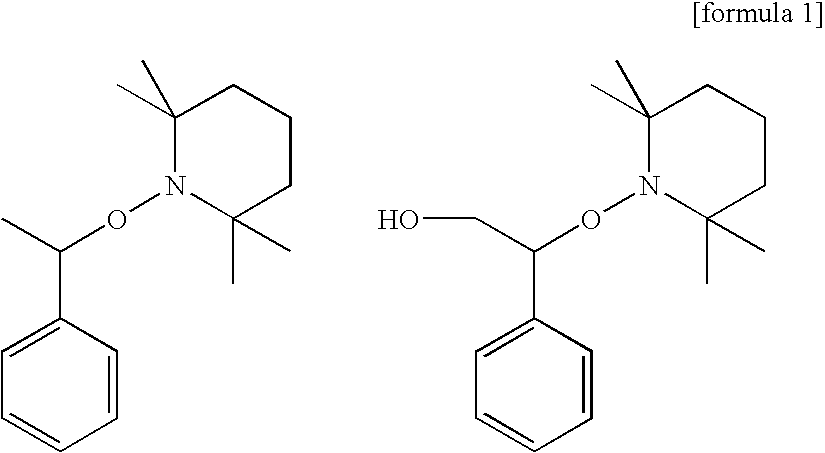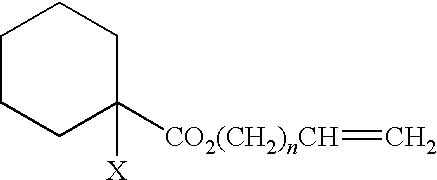Curable composition, adhesive composition containing such curable composition, and adhesive
- Summary
- Abstract
- Description
- Claims
- Application Information
AI Technical Summary
Benefits of technology
Problems solved by technology
Method used
Image
Examples
production example 1
Synthesis of poly(n-butyl acrylate / 2-ethylhexyl acrylate) Having Acryloyl Groups at Both Termini
[0147]First, n-butyl acrylate and 2-ethylhexyl acrylate were polymerized at a weight ratio of 50 / 50 using cuprous bromide as a catalyst, pentamethyldiethylenetriamine as a ligand, and diethyl 2,5-dibromoadipate as an initiator to produce bromine-terminated poly(n-butyl acrylate / 2-ethylhexyl acrylate) having a number-average molecular weight of 37,000 and a molecular weight distribution of 1.23.
[0148]Then, 200 g of the resultant polymer was dissolved in N,N-dimethylacetamide (200 mL), and 2.2 g of potassium acrylate was added to the resultant solution. The resulting mixture was heated and stirred at 70° C. for 3 hours in a nitrogen atmosphere to produce a mixture of acryloyl group-terminated poly (n-butyl acrylate / 2-ethylhexyl acrylate) (referred to as “polymer [1]” hereinafter). Then, N,N-dimethylacetamide was distilled off from the mixture under reduced pressure, and toluene was added to...
production example 2
Synthesis of poly(n-butyl acrylate / 2-ethylhexyl acrylate) Having Acryloyl Groups at Both Termini
[0149]First, n-butyl acrylate and 2-ethylhexyl acrylate were polymerized at a weight ratio of 30 / 70 using cuprous bromide as a catalyst, pentamethyldiethylenetriamine as a ligand, and diethyl 2,5-dibromoadipate as an initiator to produce bromine-terminated poly(n-butyl acrylate / 2-ethylhexyl acrylate) having a number-average molecular weight of 41,300 and a molecular weight distribution of 1.36.
[0150]Then, 200 g of the resultant polymer was dissolved in N,N-dimethylacetamide (200 mL), and 2.2 g of potassium acrylate was added to the resultant solution. The resulting mixture was heated and stirred at 70° C. for 3 hours in a nitrogen atmosphere to produce a mixture of acryloyl group-terminated poly (n-butyl acrylate / 2-ethylhexyl acrylate) (referred to as “polymer [2]” hereinafter). Then, N,N-dimethylacetamide was distilled off from the mixture under reduced pressure, and toluene was added to...
production example 3
Synthesis of poly(2-ethylhexyl acrylate) Having Acryloyl Groups at Both Termini
[0151]First, n-butyl acrylate and 2-ethylhexyl acrylate were polymerized at a weight ratio of 0 / 100 using cuprous bromide as a catalyst, pentamethyldiethylenetriamine as a ligand, and diethyl 2,5-dibromoadipate as an initiator to produce bromine-terminated poly(2-ethylhexyl acrylate) having a number-average molecular weight of 43,678 and a molecular weight distribution of 1.36.
[0152]Then, 200 g of the resultant polymer was dissolved in N,N-dimethylacetamide (1,400 mL), and 22 g of potassium acrylate was added to the resultant solution. The resulting mixture was heated and stirred at 70° C. for 21 hours in a nitrogen atmosphere to produce a mixture of acryloyl group-terminated poly(2-ethylhexyl acrylate) (referred to as “polymer [3]” hereinafter). In the functional group-introduction into this polymer, excess amount of N,N-dimethylacetamide and potassium acrylate, and longer time were needed relative to th...
PUM
| Property | Measurement | Unit |
|---|---|---|
| Percent by mass | aaaaa | aaaaa |
| Fraction | aaaaa | aaaaa |
| Weight | aaaaa | aaaaa |
Abstract
Description
Claims
Application Information
 Login to View More
Login to View More - R&D
- Intellectual Property
- Life Sciences
- Materials
- Tech Scout
- Unparalleled Data Quality
- Higher Quality Content
- 60% Fewer Hallucinations
Browse by: Latest US Patents, China's latest patents, Technical Efficacy Thesaurus, Application Domain, Technology Topic, Popular Technical Reports.
© 2025 PatSnap. All rights reserved.Legal|Privacy policy|Modern Slavery Act Transparency Statement|Sitemap|About US| Contact US: help@patsnap.com



